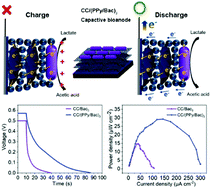Layer-by-layer construction of in situ formed polypyrrole and bacterial cells as capacitive bioanodes for paper-based microbial fuel cells†
Abstract
Introducing excellent capacitive materials and tailoring their combination modes with bacterial cells are promising steps to improve the integration degree and performance of supercapacitive paper-based microbial fuel cells (SC-PMFCs). Herein, through a layer-by-layer (LBL) strategy, in situ formed polypyrrole and bacterial cells were alternately constructed on carbon cloth for the anode of a SC-PMFC. The capacitive bioanode fabricated by three modifications of the polypyrrole/bacteria bilayer achieved the best performance due to the combined effects of bacterial loading amount, conductivity and metabolic activity loss during the whole LBL fabrication process. Benefiting from the functions of polypyrrole as both a capacitive material and a conductive intercalator between the bacterial layers, this bioanode exhibited improved electron transfer efficiency, enhanced power density and increased capacitance. Meanwhile, the polypyrrole layers in this capacitive bioanode can provide a protective effect to the bacterial layers, leading to superior performance-retention capacity during the storage period. This work creates an effective way to improve the integration level between MFC and supercapacitor technologies, which would push the development of SC-PMFCs and provide guidance to other biofuel cell-involved combination technologies.



 Please wait while we load your content...
Please wait while we load your content...